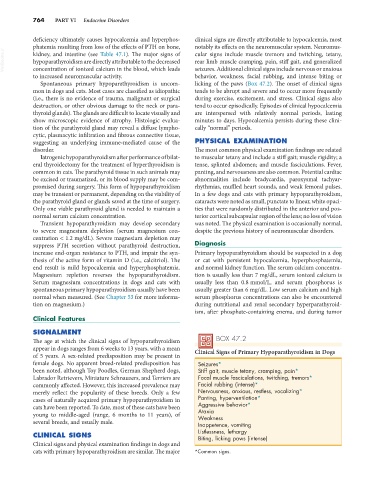Page 792 - Small Animal Internal Medicine, 6th Edition
P. 792
764 PART VI Endocrine Disorders
deficiency ultimately causes hypocalcemia and hyperphos- clinical signs are directly attributable to hypocalcemia, most
phatemia resulting from loss of the effects of PTH on bone, notably its effects on the neuromuscular system. Neuromus-
VetBooks.ir kidney, and intestine (see Table 47.1). The major signs of cular signs include muscle tremors and twitching, tetany,
rear limb muscle cramping, pain, stiff gait, and generalized
hypoparathyroidism are directly attributable to the decreased
concentration of ionized calcium in the blood, which leads
behavior, weakness, facial rubbing, and intense biting or
to increased neuromuscular activity. seizures. Additional clinical signs include nervous or anxious
Spontaneous primary hypoparathyroidism is uncom- licking of the paws (Box 47.2). The onset of clinical signs
mon in dogs and cats. Most cases are classified as idiopathic tends to be abrupt and severe and to occur more frequently
(i.e., there is no evidence of trauma, malignant or surgical during exercise, excitement, and stress. Clinical signs also
destruction, or other obvious damage to the neck or para- tend to occur episodically. Episodes of clinical hypocalcemia
thyroid glands). The glands are difficult to locate visually and are interspersed with relatively normal periods, lasting
show microscopic evidence of atrophy. Histologic evalua- minutes to days. Hypocalcemia persists during these clini-
tion of the parathyroid gland may reveal a diffuse lympho- cally “normal” periods.
cytic, plasmacytic infiltration and fibrous connective tissue,
suggesting an underlying immune-mediated cause of the PHYSICAL EXAMINATION
disorder. The most common physical examination findings are related
Iatrogenic hypoparathyroidism after performance of bilat- to muscular tetany and include a stiff gait; muscle rigidity; a
eral thyroidectomy for the treatment of hyperthyroidism is tense, splinted abdomen; and muscle fasciculations. Fever,
common in cats. The parathyroid tissue in such animals may panting, and nervousness are also common. Potential cardiac
be excised or traumatized, or its blood supply may be com- abnormalities include bradycardia, paroxysmal tachyar-
promised during surgery. This form of hypoparathyroidism rhythmias, muffled heart sounds, and weak femoral pulses.
may be transient or permanent, depending on the viability of In a few dogs and cats with primary hypoparathyroidism,
the parathyroid gland or glands saved at the time of surgery. cataracts were noted as small, punctate to linear, white opaci-
Only one viable parathyroid gland is needed to maintain a ties that were randomly distributed in the anterior and pos-
normal serum calcium concentration. terior cortical subcapsular region of the lens; no loss of vision
Transient hypoparathyroidism may develop secondary was noted. The physical examination is occasionally normal,
to severe magnesium depletion (serum magnesium con- despite the previous history of neuromuscular disorders.
centration < 1.2 mg/dL). Severe magnesium depletion may
suppress PTH secretion without parathyroid destruction, Diagnosis
increase end-organ resistance to PTH, and impair the syn- Primary hypoparathyroidism should be suspected in a dog
thesis of the active form of vitamin D (i.e., calcitriol). The or cat with persistent hypocalcemia, hyperphosphatemia,
end result is mild hypocalcemia and hyperphosphatemia. and normal kidney function. The serum calcium concentra-
Magnesium repletion reverses the hypoparathyroidism. tion is usually less than 7 mg/dL, serum ionized calcium is
Serum magnesium concentrations in dogs and cats with usually less than 0.8 mmol/L, and serum phosphorus is
spontaneous primary hypoparathyroidism usually have been usually greater than 6 mg/dL. Low serum calcium and high
normal when measured. (See Chapter 53 for more informa- serum phosphorus concentrations can also be encountered
tion on magnesium.) during nutritional and renal secondary hyperparathyroid-
ism, after phosphate-containing enema, and during tumor
Clinical Features
SIGNALMENT
The age at which the clinical signs of hypoparathyroidism BOX 47.2
appear in dogs ranges from 6 weeks to 13 years, with a mean Clinical Signs of Primary Hypoparathyroidism in Dogs
of 5 years. A sex-related predisposition may be present in
female dogs. No apparent breed-related predisposition has Seizures*
been noted, although Toy Poodles, German Shepherd dogs, Stiff gait, muscle tetany, cramping, pain*
Labrador Retrievers, Miniature Schnauzers, and Terriers are Focal muscle fasciculations, twitching, tremors*
commonly affected. However, this increased prevalence may Facial rubbing (intense)*
merely reflect the popularity of these breeds. Only a few Nervousness, anxious, restless, vocalizing*
cases of naturally acquired primary hypoparathyroidism in Panting, hyperventilation*
cats have been reported. To date, most of these cats have been Aggressive behavior*
Ataxia
young to middle-aged (range, 6 months to 11 years), of Weakness
several breeds, and usually male. Inappetence, vomiting
Listlessness, lethargy
CLINICAL SIGNS Biting, licking paws (intense)
Clinical signs and physical examination findings in dogs and
cats with primary hypoparathyroidism are similar. The major *Common signs.

